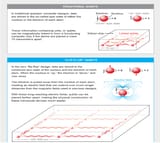Search Results
!lQuKJoUoH6/x/40763469#40763521
7/20/2025, 8:03:06 PM
Conventional computer bits represent either a one or a zero. But thanks to an
eerie quantum effect known as superposition—which allows an atom, electron or
other particle to exist in two or more states, such as ―spinning‖ in opposite directions
at once—a single qubit made of a particle in superposition can simultaneously
encompass both digits. When multiple qubits become ―entangled‖ (referring to a
quantum property that links one particle‘s actions to those of its partners), computing
capacity can rise exponentially with the number of qubits. In principle, a 300-qubit
quantum computer could perform more calculations at once than there are atoms in
the observable universe. Compare and contrast this to the aforementioned,
4,194,304 figure.
Currently, qubits based on a particle‘s spin direction must be positioned about
15 nanometers apart—any greater, and their entanglement fails. But quantum
engineers now claim to have designed qubits that can be separated by up to 500
nanometers. This provides much more room for vital apparatus to control the qubits.
To create one of these so-called ‗flip-flop‘qubits, an electron is pulled some distance
from an atom‘s nucleus. This causes the atom to exhibit positive and negative
electric poles that can interact over relatively large distances.
eerie quantum effect known as superposition—which allows an atom, electron or
other particle to exist in two or more states, such as ―spinning‖ in opposite directions
at once—a single qubit made of a particle in superposition can simultaneously
encompass both digits. When multiple qubits become ―entangled‖ (referring to a
quantum property that links one particle‘s actions to those of its partners), computing
capacity can rise exponentially with the number of qubits. In principle, a 300-qubit
quantum computer could perform more calculations at once than there are atoms in
the observable universe. Compare and contrast this to the aforementioned,
4,194,304 figure.
Currently, qubits based on a particle‘s spin direction must be positioned about
15 nanometers apart—any greater, and their entanglement fails. But quantum
engineers now claim to have designed qubits that can be separated by up to 500
nanometers. This provides much more room for vital apparatus to control the qubits.
To create one of these so-called ‗flip-flop‘qubits, an electron is pulled some distance
from an atom‘s nucleus. This causes the atom to exhibit positive and negative
electric poles that can interact over relatively large distances.
Page 1
